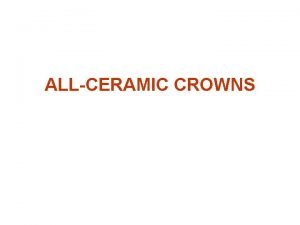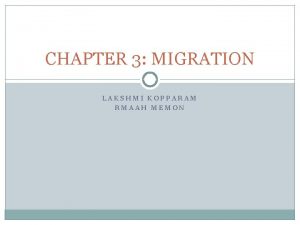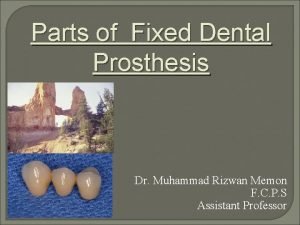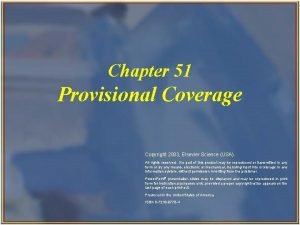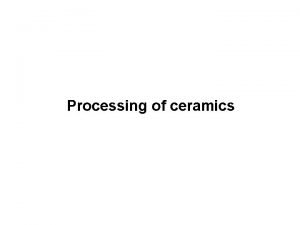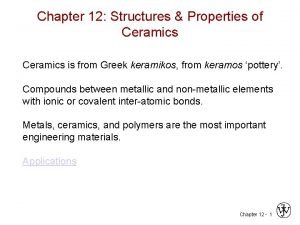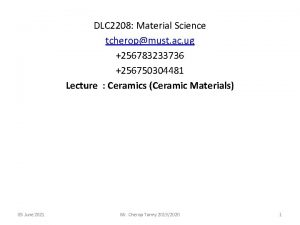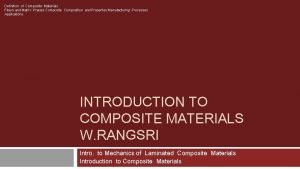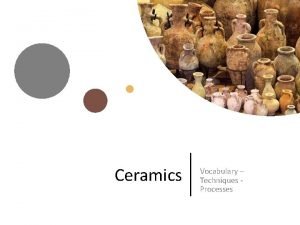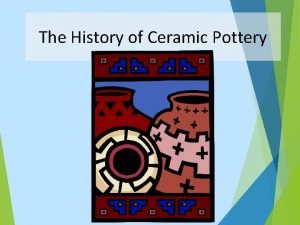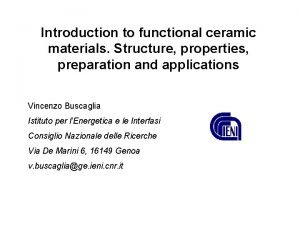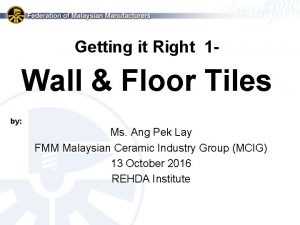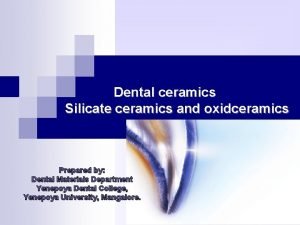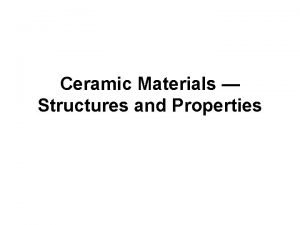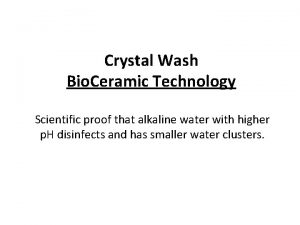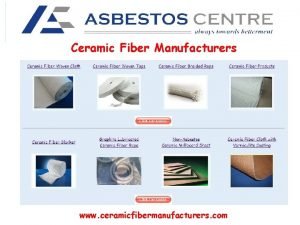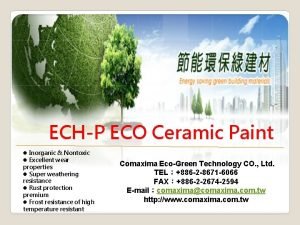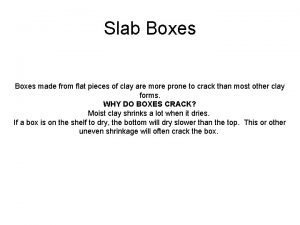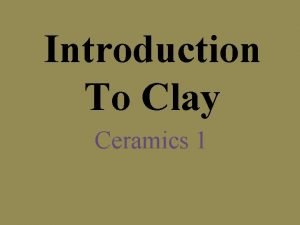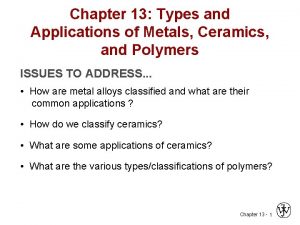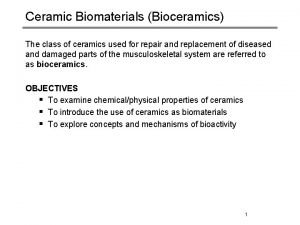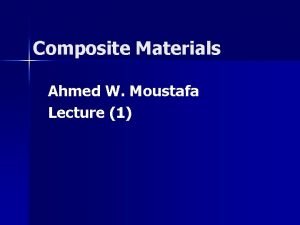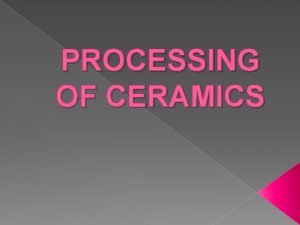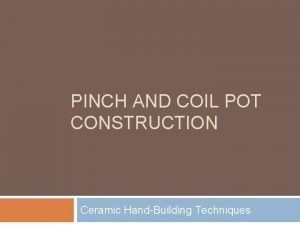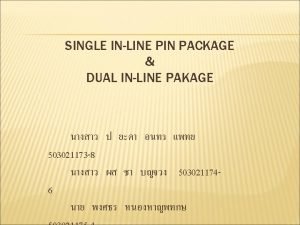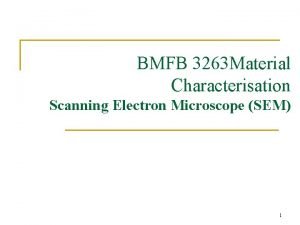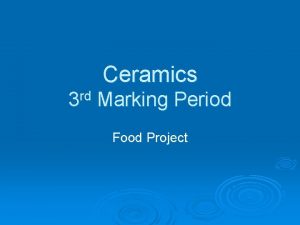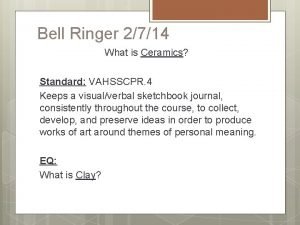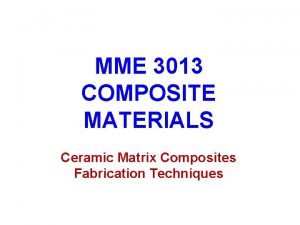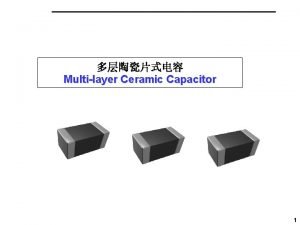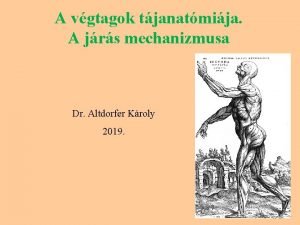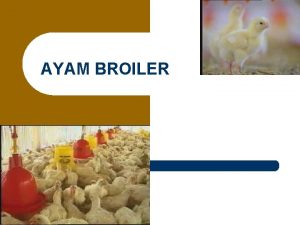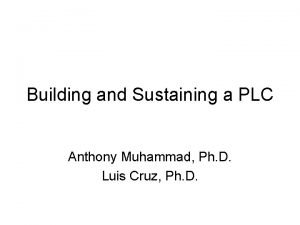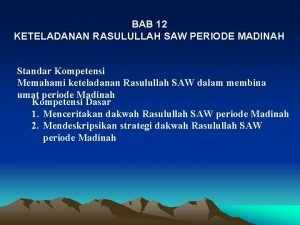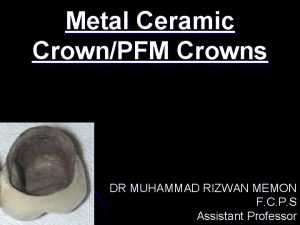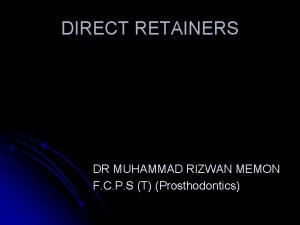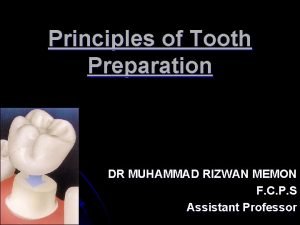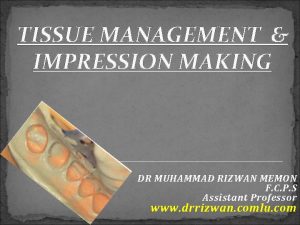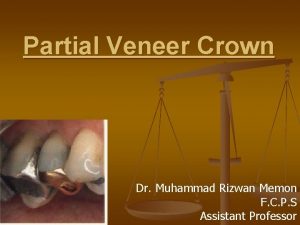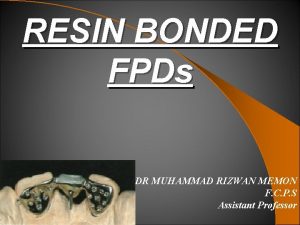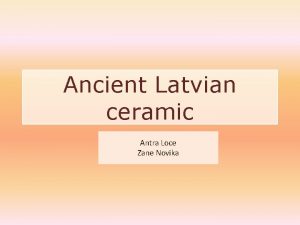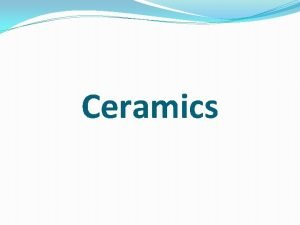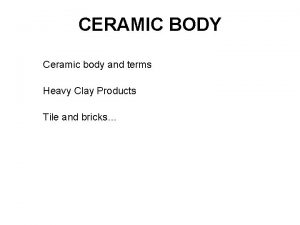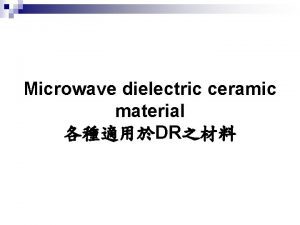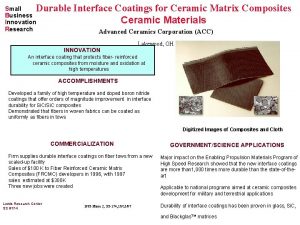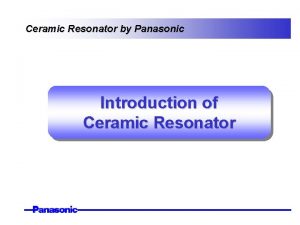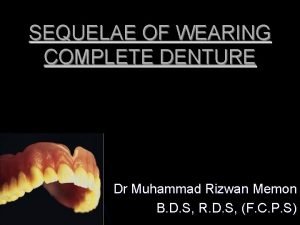All Ceramic Crowns DR MUHAMMAD RIZWAN MEMON F

























































































- Slides: 89

All Ceramic Crowns DR MUHAMMAD RIZWAN MEMON F. C. P. S Assistant Professor


All-Ceramic systems 1. Aluminous Core Ceramics High Strength ceramic core 1 st Introduced in Dentistry by Mc. Lean & Hughes in 1965 l 40% stronger than traditional porcelain l

Fabrication Procedure a. Platinum matrix fabrication

b. Aluminous core technique

2. Slip-Cast Ceramics l Strength of In-ceram is about three to four times greater than alumina core material a. In-Ceram Spinell contains magnesium spinell: High esthetics Suitable for anterior crowns and FDPs b. In-Ceram Zirconia contains zirconium oxide: High strength Suitable for posterior crowns and FDPs

Fabrication Procedure

Body & incisal Porcelain application

3. Hot-Pressed Ceramics: a. Leucite based: IPS Impress Used for crowns but not possessed adequate strength for FDPs b. Lithium Silicate based: IPS Impress 2 Used for crowns but also suitable for anterior FDPs

Heat-pressed ceramic technique:



4. Machined Ceramics: CAD/CAM Process a) Cerec System Imaging & Milling

Clay System Copy milling technique b)

C) Procera All-Ceramic system/ Scanning Die & milled Suitable for anterior FDPs

Indications OF ALL CERAMIC CROWN l High esthetic requirement, mainly indicated for anterior single crowns, also possible for posterior single crowns l New developments : 3 Unit FDP’s l Endodontically treated teeth with post & cores Incisal edge reasonably intact Favorable distribution of occlusal load Exposed metal margins Perio Problems Corrosion / Metal Intolerance l l l

Contraindications l When superior strength is warranted High caries index Insufficient coronal tooth structure for support Thin teeth faciolingually Parafunctional habits (Bruxism) Unfavorable distribution of occlusal load Inadequate Training/Understanding l Improper Connector/Pontic Space (FDP) l Bonding contraindicated if isolation cannot be achieved l l l

Advantages l Esthetically unsurpassed l Good tissue response even for subgingival margins (Biocompatable) l Slightly more conservative of facial wall than metal ceramic



Disadvantages l Reduced strength compared to metal ceramic crowns l Proper preparation extremely critical l Among least conservative preparations l Brittle nature of material l Poor marginal adaptation

CRITERIA

CRITERIA

All Ceramic Crown Preparation Design & Function Shoulder marginal integrity structural durability periodontal preservation resistance

All Ceramic Crown Preparation Design & Function Shoulder marginal integrity structural durability periodontal preservation resistance Axial Reduction retention and resistance structural durability

All Ceramic Crown Preparation Design & Function Shoulder marginal integrity structural durability periodontal preservation resistance Axial Reduction retention and resistance structural durability Rounded Line Angles structural durability

All Ceramic Crown Preparation Design & Function Shoulder marginal integrity structural durability periodontal preservation resistance Concave Cingulum Reduction Axial Reduction structural durability retention and resistance structural durability Rounded Line Angles structural durability

All Ceramic Crown Preparation Design & Function Shoulder marginal integrity structural durability periodontal preservation resistance Vertical Lingual Wall retention and resistance Concave Cingulum Reduction Axial Reduction structural durability retention and resistance structural durability Rounded Line Angles structural durability

All Ceramic Crown Preparation Design & Function Shoulder marginal integrity structural durability periodontal preservation resistance Vertical Lingual Wall retention and resistance Concave Cingulum Reduction Axial Reduction structural durability retention and resistance structural durability Rounded Line Angles structural durability

PREPARATION STEPS l Incisal (Occlusal) Reduction l Facial Reduction l Lingual Reduction l Finishing

Depth-orientation grooves






Incisal reduction

Incisal facial reduction

Gingival facial reduction

Initial proximal reduction





Lingual axial reduction






Axial wall and shoulder finishing



Resin Bonding of Ceramic Restorations l Porcelain etched with hydrofluoric acid provides mechanical retention between porcelain and resin l Silane coupling agent provides chemical bond between porcelain and resin l Routine enamel and dentin bonding procedures provide adhesion between resin cement and tooth structure

HF etch Intaglio surfaces only

Cementation Procedure 1. Remove temporary and all residue of temporary cement 2. Check occlusion on adjacent teeth (mylar shimstock and articulating paper) 3. Place rubber dam 4. Clean tooth with pumice and rubber cup, rinse and lightly dry 5. Try in restoration for fit.

6. Adjust proximal contacts if necessary 7. Evaluate shade intraorally using water soluble try-in paste (optional) 8. Rinse out try-in paste and air dry 9. Etch inside of restoration (HF porcelain etchant X 2 minutes), rinse with distilled water and air dry 10. Place drop of silane (porcelain primer) on intaglio surface for 1 minute, lightly air thin to evaporate solvent

11. Place matrix to protect adjacent teeth from etchant 12. Etch prepared tooth surfaces (phosphoric acid). Rinse and lightly air dry 13. Apply prime/bond for 15 seconds 14. Air thin for 3 seconds – AVOID POOLING 15. Light cure for 20 seconds per surface

16. Mix dual cure base and catalyst with plastic spatula (for thick restorations). Place resin cement into middle of restoration – avoid air entrapment 17. Gently seat restoration 18. Remove gross excess cement with brush, explorer and/or floss leaving slight excess at margins– AVOID ANY MOVEMENT OF THE RESTORATION 19. Light cure all surfaces for a minimum of 60 seconds per surface

20. Remove remaining cement with scalpel, gold knife or chisels 21. Evaluate contours at margins 22. Polish margins 23. Remove dam, Adjust occlusion and final polish

Acid etch and scrub for 10 seconds Rinse for 5 seconds and dry


Silanate and air thin


Etch 15 seconds Rinse & dry





Mix for 3 seconds


Air thin

Light cure 20 seconds




Mix 10 -20 seconds




Remove excess cement


Light cure all surfaces 60 seconds each

Conventional composite finishing techniques





 Depth orientation grooves
Depth orientation grooves Rmaah memon
Rmaah memon Bait rizwan
Bait rizwan Dr raja rizwan
Dr raja rizwan Dome shaped pontic
Dome shaped pontic Dr raja rizwan
Dr raja rizwan Rizwan qamar
Rizwan qamar Attahiyat in roman english
Attahiyat in roman english Dua e sabah
Dua e sabah Darling of heaven crucified
Darling of heaven crucified Crown him with many crowns 中文
Crown him with many crowns 中文 East to west casting crowns
East to west casting crowns Rising he justified freely forever
Rising he justified freely forever Crown him with many crowns 中文
Crown him with many crowns 中文 Elsevier
Elsevier 快来拥主为王
快来拥主为王 Seven eighths crown
Seven eighths crown Who am i that the lord of all the earth
Who am i that the lord of all the earth I'll praise you in the storm
I'll praise you in the storm Love them like jesus
Love them like jesus Chapter 51 provisional coverage fill in the blank
Chapter 51 provisional coverage fill in the blank Name three lines
Name three lines Ceramic processing upscaling
Ceramic processing upscaling Structures and properties of ceramics
Structures and properties of ceramics Ceramic classification
Ceramic classification Matrix phase meaning
Matrix phase meaning Pug mill ceramics definition
Pug mill ceramics definition Yag ceramic
Yag ceramic Ceramic mold casting advantages and disadvantages
Ceramic mold casting advantages and disadvantages Ceramic timeline
Ceramic timeline Functional ceramics application
Functional ceramics application Tiles price list
Tiles price list Dental silicate ceramic
Dental silicate ceramic Ionic materials
Ionic materials Koptri
Koptri Drift current and diffusion current in semiconductor
Drift current and diffusion current in semiconductor Ceramic fiber manufacturer
Ceramic fiber manufacturer Non toxic ceramic paint
Non toxic ceramic paint Ceramic slab boxes
Ceramic slab boxes Glazeware ceramics definition
Glazeware ceramics definition Dominican faceless dolls history
Dominican faceless dolls history Ceramic classification
Ceramic classification Ceramic biomaterials examples
Ceramic biomaterials examples Ceramic matrix composites definition
Ceramic matrix composites definition Plastic forming ceramic
Plastic forming ceramic Ceramic construction techniques
Ceramic construction techniques Ceramic processing upscaling
Ceramic processing upscaling Dual inline package use
Dual inline package use Why is ceramic wool heated in cracking
Why is ceramic wool heated in cracking Ceramic semiconductor thermometer
Ceramic semiconductor thermometer Microscope
Microscope Ceramic food project
Ceramic food project What is ceramic
What is ceramic Ceramic matrix composites definition
Ceramic matrix composites definition Multi plane
Multi plane Itc semmelweis
Itc semmelweis I work all night
I work all night 1012069
1012069 Love all serve all help ever hurt never
Love all serve all help ever hurt never Silent night holy night all is calm
Silent night holy night all is calm All to one reduction
All to one reduction What heights of love what depths of peace
What heights of love what depths of peace Interventi sociali rivolti all'infanzia e all'adolescenza
Interventi sociali rivolti all'infanzia e all'adolescenza You are my all in all images
You are my all in all images Above all powers
Above all powers Sistem all in all out
Sistem all in all out Above all powers
Above all powers All of you is more than enough for all of me
All of you is more than enough for all of me Muhammad ali mbti
Muhammad ali mbti Muhammad amjad saqib
Muhammad amjad saqib Muhammad ismail yusanto
Muhammad ismail yusanto Oasis islam definition
Oasis islam definition Dr muhammad irfan
Dr muhammad irfan Dr muhammad ali yousuf
Dr muhammad ali yousuf Zahiriddin muhammad bobur haqida
Zahiriddin muhammad bobur haqida Banu muhammad
Banu muhammad Anthony muhammad
Anthony muhammad Allahumma sallimni ila ramadan
Allahumma sallimni ila ramadan What is mental health
What is mental health Sayyidina
Sayyidina Dakwah rasulullah periode madinah berlangsung selama
Dakwah rasulullah periode madinah berlangsung selama Muhammad hasmi abu hassan asaari
Muhammad hasmi abu hassan asaari Love makes the world go round meaning
Love makes the world go round meaning Rumusan tentang nabi muhammad saw
Rumusan tentang nabi muhammad saw Dante alegheri
Dante alegheri Silsilah keturunan prabu siliwangi
Silsilah keturunan prabu siliwangi Imam muhammad bin idris
Imam muhammad bin idris Qualities of muhammad
Qualities of muhammad Nama perusahaan abjad
Nama perusahaan abjad Jesus vs muhammad
Jesus vs muhammad
